[English] 日本語
 Yorodumi
Yorodumi- PDB-1fzc: CRYSTAL STRUCTURE OF FRAGMENT DOUBLE-D FROM HUMAN FIBRIN WITH TWO... -
+ Open data
Open data
- Basic information
Basic information
| Entry | Database: PDB / ID: 1fzc | ||||||||||||
|---|---|---|---|---|---|---|---|---|---|---|---|---|---|
| Title | CRYSTAL STRUCTURE OF FRAGMENT DOUBLE-D FROM HUMAN FIBRIN WITH TWO DIFFERENT BOUND LIGANDS | ||||||||||||
 Components Components | (FIBRIN) x 5 | ||||||||||||
 Keywords Keywords | BLOOD COAGULATION / PLASMA PROTEIN / CROSSLINKING | ||||||||||||
| Function / homology |  Function and homology information Function and homology informationblood coagulation, common pathway / induction of bacterial agglutination / fibrinogen complex / Regulation of TLR by endogenous ligand / platelet alpha granule / blood coagulation, fibrin clot formation / cellular response to leptin stimulus / MyD88 deficiency (TLR2/4) / positive regulation of heterotypic cell-cell adhesion / IRAK4 deficiency (TLR2/4) ...blood coagulation, common pathway / induction of bacterial agglutination / fibrinogen complex / Regulation of TLR by endogenous ligand / platelet alpha granule / blood coagulation, fibrin clot formation / cellular response to leptin stimulus / MyD88 deficiency (TLR2/4) / positive regulation of heterotypic cell-cell adhesion / IRAK4 deficiency (TLR2/4) / extracellular matrix structural constituent / MyD88:MAL(TIRAP) cascade initiated on plasma membrane / plasminogen activation / p130Cas linkage to MAPK signaling for integrins / positive regulation of peptide hormone secretion / positive regulation of vasoconstriction / GRB2:SOS provides linkage to MAPK signaling for Integrins / protein secretion / positive regulation of exocytosis / protein polymerization / cellular response to interleukin-1 / Integrin cell surface interactions / negative regulation of endothelial cell apoptotic process / Common Pathway of Fibrin Clot Formation / negative regulation of extrinsic apoptotic signaling pathway via death domain receptors / fibrinolysis / cell adhesion molecule binding / Integrin signaling / positive regulation of substrate adhesion-dependent cell spreading / platelet alpha granule lumen / cell-matrix adhesion / positive regulation of protein secretion / Post-translational protein phosphorylation / Signaling by high-kinase activity BRAF mutants / response to calcium ion / MAP2K and MAPK activation / platelet aggregation / Regulation of Insulin-like Growth Factor (IGF) transport and uptake by Insulin-like Growth Factor Binding Proteins (IGFBPs) / Signaling by RAF1 mutants / Signaling by moderate kinase activity BRAF mutants / Paradoxical activation of RAF signaling by kinase inactive BRAF / Signaling downstream of RAS mutants / Signaling by BRAF and RAF1 fusions / Platelet degranulation / extracellular vesicle / : / protein-folding chaperone binding / ER-Phagosome pathway / protein-containing complex assembly / cell cortex / protein-macromolecule adaptor activity / blood microparticle / adaptive immune response / positive regulation of ERK1 and ERK2 cascade / endoplasmic reticulum lumen / Amyloid fiber formation / signaling receptor binding / innate immune response / external side of plasma membrane / synapse / structural molecule activity / cell surface / endoplasmic reticulum / extracellular space / extracellular exosome / extracellular region / metal ion binding / plasma membrane Similarity search - Function | ||||||||||||
| Biological species |  Homo sapiens (human) Homo sapiens (human) | ||||||||||||
| Method |  X-RAY DIFFRACTION / X-RAY DIFFRACTION /  SYNCHROTRON / SYNCHROTRON /  MOLECULAR REPLACEMENT / Resolution: 2.3 Å MOLECULAR REPLACEMENT / Resolution: 2.3 Å | ||||||||||||
 Authors Authors | Everse, S.J. / Spraggon, G. / Veerapandian, L. / Riley, M. / Doolittle, R.F. | ||||||||||||
 Citation Citation |  Journal: Biochemistry / Year: 1998 Journal: Biochemistry / Year: 1998Title: Crystal structure of fragment double-D from human fibrin with two different bound ligands. Authors: Everse, S.J. / Spraggon, G. / Veerapandian, L. / Riley, M. / Doolittle, R.F. #1:  Journal: Nature / Year: 1997 Journal: Nature / Year: 1997Title: Crystal Structures of Fragment D from Human Fibrinogen and its Crosslinked Counterpart from Fibrin Authors: Spraggon, G. / Everse, S.J. / Doolittle, R.F. #2:  Journal: Nature / Year: 1997 Journal: Nature / Year: 1997Title: Erratum. Crystal Structures of Fragment D from Human Fibrinogen and its Crosslinked Counterpart from Fibrin Authors: Spraggon, G. / Everse, S.J. / Doolittle, R.F. | ||||||||||||
| History |
|
- Structure visualization
Structure visualization
| Structure viewer | Molecule:  Molmil Molmil Jmol/JSmol Jmol/JSmol |
|---|
- Downloads & links
Downloads & links
- Download
Download
| PDBx/mmCIF format |  1fzc.cif.gz 1fzc.cif.gz | 304.6 KB | Display |  PDBx/mmCIF format PDBx/mmCIF format |
|---|---|---|---|---|
| PDB format |  pdb1fzc.ent.gz pdb1fzc.ent.gz | 239.8 KB | Display |  PDB format PDB format |
| PDBx/mmJSON format |  1fzc.json.gz 1fzc.json.gz | Tree view |  PDBx/mmJSON format PDBx/mmJSON format | |
| Others |  Other downloads Other downloads |
-Validation report
| Summary document |  1fzc_validation.pdf.gz 1fzc_validation.pdf.gz | 552 KB | Display |  wwPDB validaton report wwPDB validaton report |
|---|---|---|---|---|
| Full document |  1fzc_full_validation.pdf.gz 1fzc_full_validation.pdf.gz | 637.9 KB | Display | |
| Data in XML |  1fzc_validation.xml.gz 1fzc_validation.xml.gz | 40.3 KB | Display | |
| Data in CIF |  1fzc_validation.cif.gz 1fzc_validation.cif.gz | 60.3 KB | Display | |
| Arichive directory |  https://data.pdbj.org/pub/pdb/validation_reports/fz/1fzc https://data.pdbj.org/pub/pdb/validation_reports/fz/1fzc ftp://data.pdbj.org/pub/pdb/validation_reports/fz/1fzc ftp://data.pdbj.org/pub/pdb/validation_reports/fz/1fzc | HTTPS FTP |
-Related structure data
| Similar structure data |
|---|
- Links
Links
- Assembly
Assembly
| Deposited unit | 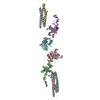
| ||||||||||||||||
|---|---|---|---|---|---|---|---|---|---|---|---|---|---|---|---|---|---|
| 1 |
| ||||||||||||||||
| Unit cell |
| ||||||||||||||||
| Noncrystallographic symmetry (NCS) | NCS oper:
|
- Components
Components
-Protein , 3 types, 6 molecules ADBECF
| #1: Protein | Mass: 10244.963 Da / Num. of mol.: 2 / Fragment: DOUBLE-D / Source method: isolated from a natural source / Source: (natural)  Homo sapiens (human) / Organ: BLOOD / Tissue: BLOOD / References: UniProt: P02671 Homo sapiens (human) / Organ: BLOOD / Tissue: BLOOD / References: UniProt: P02671#2: Protein | Mass: 37691.992 Da / Num. of mol.: 2 / Fragment: DOUBLE-D / Source method: isolated from a natural source / Source: (natural)  Homo sapiens (human) / Organ: BLOOD / Tissue: BLOOD / References: UniProt: P02675 Homo sapiens (human) / Organ: BLOOD / Tissue: BLOOD / References: UniProt: P02675#3: Protein | Mass: 36223.281 Da / Num. of mol.: 2 / Fragment: DOUBLE-D / Source method: isolated from a natural source / Source: (natural)  Homo sapiens (human) / Organ: BLOOD / Tissue: BLOOD / References: UniProt: P02679 Homo sapiens (human) / Organ: BLOOD / Tissue: BLOOD / References: UniProt: P02679 |
|---|
-Protein/peptide , 2 types, 4 molecules GHIJ
| #4: Protein/peptide | Mass: 426.490 Da / Num. of mol.: 2 / Fragment: DOUBLE-D / Source method: isolated from a natural source / Source: (natural)  Homo sapiens (human) / Tissue: BLOOD Homo sapiens (human) / Tissue: BLOOD#5: Protein/peptide | Mass: 467.522 Da / Num. of mol.: 2 / Fragment: DOUBLE-D / Source method: isolated from a natural source / Source: (natural)  Homo sapiens (human) / Tissue: BLOOD Homo sapiens (human) / Tissue: BLOOD |
|---|
-Sugars , 3 types, 4 molecules 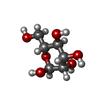


| #6: Polysaccharide | 2-acetamido-2-deoxy-beta-D-glucopyranose-(1-4)-2-acetamido-2-deoxy-beta-D-glucopyranose Source method: isolated from a genetically manipulated source |
|---|---|
| #7: Sugar | ChemComp-MAN / |
| #9: Sugar |
-Non-polymers , 2 types, 435 molecules 


| #8: Chemical | ChemComp-CA / #10: Water | ChemComp-HOH / | |
|---|
-Details
| Has protein modification | Y |
|---|---|
| Sequence details | G1-G4: THIS PEPTIDE MIMICS A17-A20 OF THE FIBRIN SEQUENCE WITH PRO G 4 REPLACING VAL A 20 OF THE ...G1-G4: THIS PEPTIDE MIMICS A17-A20 OF THE FIBRIN SEQUENCE WITH PRO G 4 REPLACING VAL A 20 OF THE FIBRIN SEQUENCE. H1-H4: THIS PEPTIDE MIMICS D17-D20 OF THE FIBRIN SEQUENCE WITH PRO H 4 REPLACING VAL D 20 OF THE FIBRIN SEQUENCE. I1-I4: THIS PEPTIDE MIMICS B15-B18 OF THE FIBRIN SEQUENCE. J1-J4: THIS PEPTIDE MIMICS E15-E18 OF THE FIBRIN SEQUENCE. |
-Experimental details
-Experiment
| Experiment | Method:  X-RAY DIFFRACTION / Number of used crystals: 1 X-RAY DIFFRACTION / Number of used crystals: 1 |
|---|
- Sample preparation
Sample preparation
| Crystal | Density Matthews: 2.66 Å3/Da / Density % sol: 50 % | ||||||||||||||||||||||||||||||||||||||||||||||||||||||||||||
|---|---|---|---|---|---|---|---|---|---|---|---|---|---|---|---|---|---|---|---|---|---|---|---|---|---|---|---|---|---|---|---|---|---|---|---|---|---|---|---|---|---|---|---|---|---|---|---|---|---|---|---|---|---|---|---|---|---|---|---|---|---|
| Crystal grow | pH: 7 Details: 12% PEG 3350, 50 MM TRIS PH 7.0, 5 MM CALCIUM CHLORIDE, 1MM SODIUM AZIDE, 5MM GLY-PRO-ARG-PRO-AMIDE, 5MM GLY-HIS-ARG-PRO-AMIDE | ||||||||||||||||||||||||||||||||||||||||||||||||||||||||||||
| Crystal | *PLUS | ||||||||||||||||||||||||||||||||||||||||||||||||||||||||||||
| Crystal grow | *PLUS Method: vapor diffusion, sitting drop | ||||||||||||||||||||||||||||||||||||||||||||||||||||||||||||
| Components of the solutions | *PLUS
|
-Data collection
| Diffraction | Mean temperature: 100 K |
|---|---|
| Diffraction source | Source:  SYNCHROTRON / Site: SYNCHROTRON / Site:  CHESS CHESS  / Beamline: A1 / Wavelength: 0.91 / Beamline: A1 / Wavelength: 0.91 |
| Detector | Type: ADSC QUANTUM / Detector: CCD / Date: Aug 1, 1997 |
| Radiation | Monochromatic (M) / Laue (L): M / Scattering type: x-ray |
| Radiation wavelength | Wavelength: 0.91 Å / Relative weight: 1 |
| Reflection | Resolution: 2.3→30 Å / Num. obs: 81010 / % possible obs: 94.5 % / Observed criterion σ(I): 0 / Redundancy: 4.6 % / Rmerge(I) obs: 0.093 |
| Reflection | *PLUS Num. measured all: 376448 |
- Processing
Processing
| Software |
| |||||||||||||||||||||||||||||||||||||||||||||||||||||||||||||||
|---|---|---|---|---|---|---|---|---|---|---|---|---|---|---|---|---|---|---|---|---|---|---|---|---|---|---|---|---|---|---|---|---|---|---|---|---|---|---|---|---|---|---|---|---|---|---|---|---|---|---|---|---|---|---|---|---|---|---|---|---|---|---|---|---|
| Refinement | Method to determine structure:  MOLECULAR REPLACEMENT MOLECULAR REPLACEMENTStarting model: FIBRINOGEN FRAGMENT D Resolution: 2.3→20 Å / Cross valid method: THROUGHOUT / σ(F): 0 Details: X-PLOR WAS ALSO USED IN THE EARLY STAGES OF REFINEMENT. RESIDUES ASN B 364 AND ASN E 364 ARE GLYCOSYLATED BY BIANNTENARY OLIGOSACCHARIDE CHAINS, ONLY THREE RESIDUES OF WHICH WERE VISIBLE IN ...Details: X-PLOR WAS ALSO USED IN THE EARLY STAGES OF REFINEMENT. RESIDUES ASN B 364 AND ASN E 364 ARE GLYCOSYLATED BY BIANNTENARY OLIGOSACCHARIDE CHAINS, ONLY THREE RESIDUES OF WHICH WERE VISIBLE IN THE ELECTRON DENSITY FOR THE B CHAIN AND TWO FOR THE E CHAIN.
| |||||||||||||||||||||||||||||||||||||||||||||||||||||||||||||||
| Displacement parameters | Biso mean: 17.8 Å2 | |||||||||||||||||||||||||||||||||||||||||||||||||||||||||||||||
| Refinement step | Cycle: LAST / Resolution: 2.3→20 Å
| |||||||||||||||||||||||||||||||||||||||||||||||||||||||||||||||
| Refine LS restraints |
| |||||||||||||||||||||||||||||||||||||||||||||||||||||||||||||||
| Software | *PLUS Name: REFMAC / Classification: refinement | |||||||||||||||||||||||||||||||||||||||||||||||||||||||||||||||
| Refinement | *PLUS Rfactor obs: 0.22 | |||||||||||||||||||||||||||||||||||||||||||||||||||||||||||||||
| Solvent computation | *PLUS | |||||||||||||||||||||||||||||||||||||||||||||||||||||||||||||||
| Displacement parameters | *PLUS |
 Movie
Movie Controller
Controller



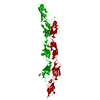
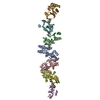
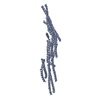



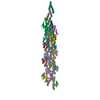


 PDBj
PDBj















